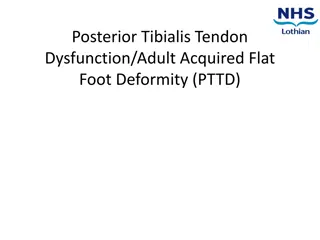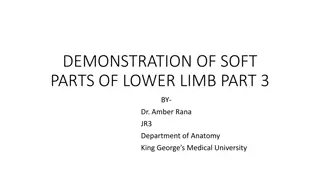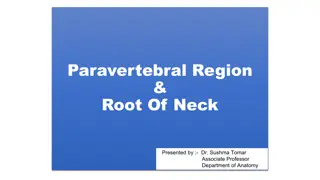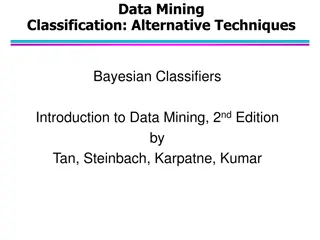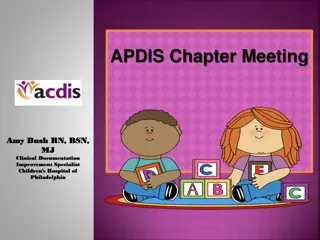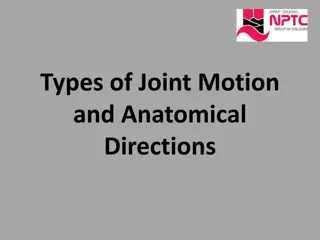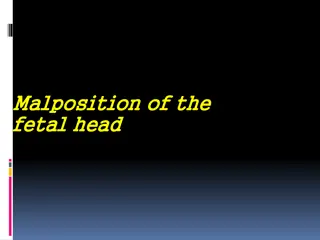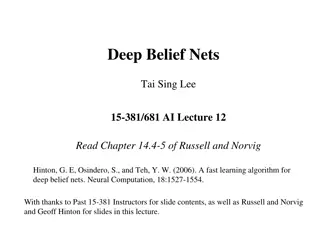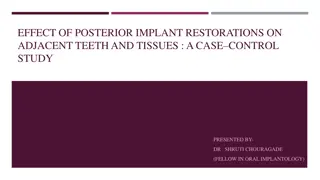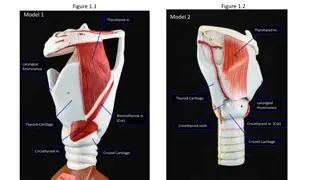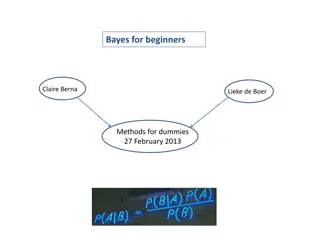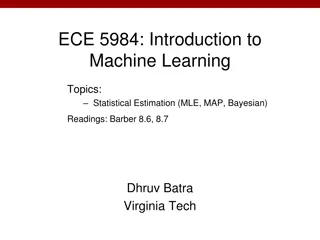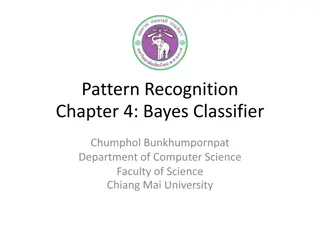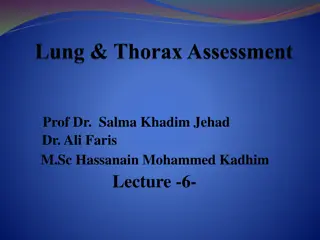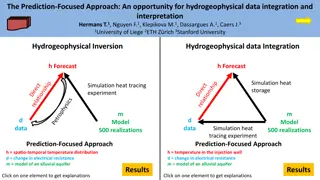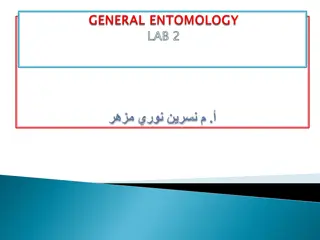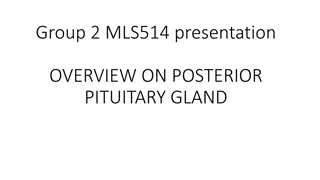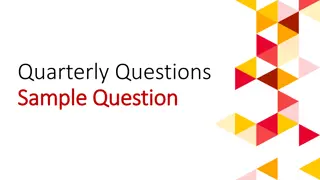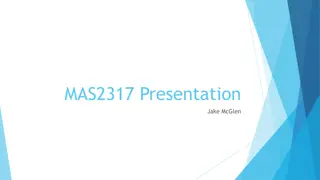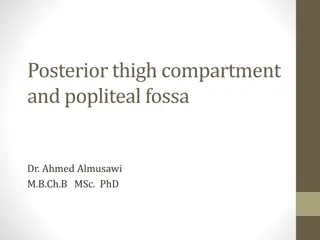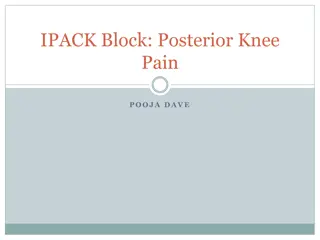Demonstration of Soft Parts of Lower Limb - Part 3 by Dr. Amber Rana at King George's Medical University
This presentation outlines the structures of the lateral compartment of the leg, posterior compartment of the leg, and dorsum of the foot. It includes information on boundaries, muscles, nerves, and vessels in each region, along with detailed descriptions of specific structures such as the peroneus
1 views • 15 slides
Posterior Tibialis Tendon Dysfunction (PTTD) in Adults
Posterior Tibialis Tendon Dysfunction, also known as Adult Acquired Flat Foot Deformity (PTTD), is a condition that affects the tibialis posterior tendon, leading to reduced arch support. Common causes include obesity, trauma, age, and existing health conditions. Symptoms may include ankle pain, swe
2 views • 12 slides
Comprehensive Guide to Ophthalmic Examination in Veterinary Medicine
A detailed guide on the ophthalmic examination of animals led by Dr. Bipin Kumar, Assistant Professor at the Bihar Veterinary College. The examination covers history taking, general physical examination, evaluation of vision, pupil function, eyelid function, adnexal and anterior segment examination,
38 views • 9 slides
Demonstration of Lower Limb Soft Tissues - Part 3
This detailed demonstration by Dr. Amber Rana from King George's Medical University focuses on identifying and describing the structures of the lateral compartment of the leg, posterior compartment of the leg, and dorsum of the foot. It covers boundaries, muscles, nerves, and vessels present in each
2 views • 15 slides
Anatomy of Paravertebral Region and Root of Neck
This informative content presents the paravertebral region and the muscles of the neck, including the scalene muscles (posterior, medius, and anterior). It covers the origin, insertion, nerve supply, and actions of these muscles, providing a clear understanding of their functions. Additionally, it d
1 views • 18 slides
Anatomy of the Upper Limb: Clavicle, Scapula, Humerus
The upper limb anatomy includes detailed descriptions of the clavicle, scapula, and humerus bones. The clavicle is a long bone that articulates with the sternum and scapula, while the scapula lies on the posterior chest wall and has important bony landmarks like the acromion and glenoid cavity. The
13 views • 15 slides
Introduction to Bayesian Classifiers in Data Mining
Bayesian classifiers are a key technique in data mining for solving classification problems using probabilistic frameworks. This involves understanding conditional probability, Bayes' theorem, and applying these concepts to make predictions based on given data. The process involves estimating poster
3 views • 20 slides
Bayesian Inference with Beta Prior in Coin Toss Experiment
Suppose you have a Beta(4,.4) prior distribution on the probability of a coin yielding a head. After spinning the coin ten times and observing fewer than 3 heads, the exact posterior density is calculated. The posterior distribution is plotted and analyzed, showing how the prior influences the updat
8 views • 15 slides
Clinical Documentation Case Study: Posterior Fossa Syndrome and Mutism in Pediatric Patient
A case study of Kaye, a 3-year-old with a posterior fossa mass and obstructive hydrocephalus, highlights the importance of accurate clinical documentation. CDI queries to the physician clarified the distinction between posterior fossa mutism and syndrome, impacting coding accuracy and patient care o
4 views • 11 slides
Bayesian Classification and Intelligent Information Retrieval
Bayesian classification involves methods based on probability theory, with Bayes' theorem playing a critical role in probabilistic learning and categorization. It utilizes prior and posterior probability distributions to determine category given a description. Intelligent Information Retrieval compl
1 views • 19 slides
Radiology Case Presentation: Differential Diagnosis of Large Posterior Fossa Mass in 25-Year-Old Male
25-year-old male with persistent headaches and neck pain presents with worsening symptoms. Differential diagnosis includes primary brain tumor, pyogenic abscess, pilocytic astrocytoma, medulloblastoma, and other possibilities. Neurocysticercosis, a parasitic disease caused by T. solium, endemic in c
0 views • 18 slides
Invariance in Posterior Distributions
Exploring the insensitivity of posterior distributions to variations in prior distributions using a Poisson model applied to pancreas data. The analysis involves calculating posterior mean and standard deviation with different Gamma prior distributions. Results showcase minimal change in outcomes ac
3 views • 7 slides
Essential Joint Motions and Anatomical Directions Explained
Explore various types of joint motions such as abduction, flexion, rotation, and more, along with anatomical directions like anterior, posterior, superior, and inferior. Understand the body's movements and positions with detailed illustrations in the anatomical context.
2 views • 10 slides
Occipito-Posterior Position of the Fetal Head
Occipito-posterior position of the fetal head occurs when the head is in one of the oblique diameters with the occiput directed posteriorly. It can be categorized into Right Occipito-Posterior Position (ROP) and Left Occipito-Posterior Position (LOP), affecting 13% of vertex presentations. Causes in
4 views • 32 slides
Occipito-Posterior Position of the Fetal Head
Occipito-posterior position refers to the fetal head being directed towards the back of the pelvis. This positioning can occur to the right (ROP) or left (LOP) side. It occurs in 13% of vertex presentations and may be caused by factors like pendulous abdomen, pelvic brim shape, or sacral alignment.
4 views • 31 slides
Introduction to Deep Belief Nets and Probabilistic Inference Methods
Explore the concepts of deep belief nets and probabilistic inference methods through lecture slides covering topics such as rejection sampling, likelihood weighting, posterior probability estimation, and the influence of evidence variables on sampling distributions. Understand how evidence affects t
4 views • 47 slides
Effect of Posterior Implant Restorations on Adjacent Teeth and Tissues: A Case Control Study
The study delves into the impact of posterior dental implant rehabilitation on adjacent natural teeth, exploring complications such as caries, cracks, fractures, and mobility. Factors such as proximal contact integrity, peri-implantitis effects, and occlusal load redistribution are considered. The o
4 views • 13 slides
Anatomy of the Larynx: Detailed Illustrations and Muscle Actions
Detailed illustrations and descriptions of the anatomy of the larynx, including structures such as the thyroid cartilage, epiglottis, vocal folds, and muscles like the cricothyroid and posterior cricoarytenoid. The images depict the laryngeal landmarks, ligaments, and nerves, providing a comprehensi
5 views • 5 slides
Probabilistic Graphical Models Part 2: Inference and Learning
This segment delves into various types of inferences in probabilistic graphical models, including marginal inference, posterior inference, and maximum a posteriori inference. It also covers methods like variable elimination, belief propagation, and junction tree for exact inference, along with appro
1 views • 33 slides
Introduction to Bayes' Rule: Understanding Probabilistic Inference
An overview of Bayes' rule, a fundamental concept in probabilistic inference, is presented in this text. It explains how to calculate conditional probabilities, likelihoods, priors, and posterior probabilities using Bayes' rule through examples like determining the likelihood of rain based on a wet
5 views • 21 slides
Introduction to Statistical Estimation in Machine Learning
Explore the fundamental concepts of statistical estimation in machine learning, including Maximum Likelihood Estimation (MLE), Maximum A Posteriori (MAP), and Bayesian estimation. Learn about key topics such as probabilities, interpreting probabilities from different perspectives, marginal distribut
8 views • 23 slides
Bayes Classifier in Pattern Recognition
Bayes Classifier is a simple probabilistic classifier that minimizes error probability by utilizing prior and posterior probabilities. It assigns class labels based on maximum posterior probability, making it an optimal tool for classification tasks. This chapter covers the Bayes Theorem, classifica
2 views • 24 slides
Comprehensive Lung Examination and Assessment Techniques
This detailed guide provides insights into conducting a thorough lung examination, including objectives, equipment needed, preparation steps, subjective data assessment, chest landmarks identification, inspection of the thorax's anterior, posterior, and lateral aspects, and evaluation of breathing p
3 views • 30 slides
Enhancing Hydrogeophysical Data Integration with the Prediction-Focused Approach
The Prediction-Focused Approach (PFA) offers a unique Bayesian method for integrating and interpreting hydrogeophysical data. Unlike traditional methods, PFA focuses on forecasting target variables rather than model parameters, utilizing an ensemble of prior models to establish a direct relationship
6 views • 23 slides
The Anatomy of an Insect Head: A Detailed Look
Explore the intricate structures of an insect head, including the segmentation, sclerites, sutures, and specialized features like the occiput and ocular sclerites. Discover the unique characteristics that define the head capsule in insects through frontal, lateral, dorsal, and posterior views, shedd
3 views • 10 slides
The Posterior Pituitary Gland and Its Hormones
The posterior pituitary gland, a key part of the endocrine system, plays a vital role in hormone secretion. It controls the release of oxytocin and vasopressin, influencing social bonding, reproduction, and childbirth. Learn about the anatomy, function, and disorders associated with this important g
2 views • 26 slides
Managing Intraoperative Floppy Iris Syndrome in Cataract Surgery
Effective management of intraoperative floppy iris syndrome in cataract surgery involves specific maneuvers such as reducing aspiration flow rate, using mechanical iris expansion devices, and avoiding large or posterior incisions. This condition is characterized by progressive pupil constriction, ir
0 views • 6 slides
Bayesian Analysis of Oxygen Consumption Rates in Athletes
The sports scientist measures the rate of oxygen consumption in athletes after exercise, with a sample mean of 2.25 litres per minute and a standard deviation of 1.6. Using Bayesian analysis with vague prior knowledge, a posterior distribution is obtained. The 95% Bayesian confidence interval is cal
3 views • 6 slides
Posterior Thigh Compartment and Popliteal Fossa Overview
Explore the boundaries, contents, muscles, blood supply, nerve supply, and structures of the posterior thigh compartment and popliteal fossa. Study the cutaneous innervation, sciatic nerve, popliteal artery, and detailed anatomy of this region through informative images and descriptions provided by
0 views • 16 slides
Posterior Polymorphous Membrane Dystrophy: Diagnosis and Treatment
A 38-year-old female presented with blurry vision and eye pain. After medical management failed to resolve corneal edema, Descemet stripping automated endothelial keratoplasty was performed on her left eye due to posterior polymorphous membrane dystrophy. Learn about this bilateral, nonprogressive,
3 views • 14 slides
Posterior Circulation Aneurysms Overview
Posterior circulation aneurysms account for 15% of intracranial aneurysms, primarily affecting females in their fifth and sixth decades of life. They can manifest as saccular, fusiform, or dissecting types, with common locations including the basilar apex, origins of various arteries, and the basila
2 views • 38 slides
Physiology of Hormones Secreted by the Posterior Pituitary Gland
Explore the functions of the hormones oxytocin and antidiuretic hormone (ADH) secreted by the posterior pituitary gland. Learn about their roles in uterine contractions, milk secretion, blood pressure regulation, and water reabsorption. Understand conditions like hypopituitarism and gonadotropins di
1 views • 12 slides
Posterior Pituitary Hormones and Related Disorders
Explore the physiology of posterior pituitary hormones such as oxytocin and vasopressin, their functions in the body, and disorders like hypopituitarism and gonadotropin disorders. Learn how these hormones affect processes like labor, milk ejection, and blood pressure regulation.
1 views • 12 slides
Physiology of Posterior Pituitary Gland and Hypothalamic Control
Explore the endocrinology and structure of the posterior pituitary gland, including the synthesis of hormones like ADH and oxytocin. Learn about the hypothalamic-pituitary relationships and the mechanisms of hormone secretion and action in the body.
2 views • 19 slides
Comprehensive Dental Case Study: Edentulous Posterior Implant Restoration
Explore a detailed dental case study involving an edentulous posterior mandible or maxillary quadrant with root form implants and its restoration process. The case study includes medical history, patient examination, social history, treatment planning, prosthodontic rehabilitation plan, and more. Vi
1 views • 27 slides
Comprehensive Case Study: Edentulous Posterior Maxilla with Sinus Augmentation and Implant Restoration
Explore a detailed case study involving an edentulous posterior maxilla requiring sinus augmentation, implant placement, and restoration. Dive into the patient's medical history, examination findings, social history, radiographs, and treatment planning details.
6 views • 29 slides
Effective Ankle Taping Study for Fast Bowlers with Posterior Ankle Impingement
Discover the effectiveness of ankle taping in managing posterior ankle impingement syndrome in fast bowlers through a study evaluating different degrees of plantar flexion restriction. Learn about the impact on bowling performance and injury prevention for cricket players.
4 views • 23 slides
Innovative Pain Management Technique for Posterior Knee Pain
Learn about the IPACK Block technique, an advanced approach for managing posterior knee pain during knee procedures. This ultrasound-guided infiltration method targets specific nerves to provide effective pain relief without motor block, improving patient outcomes and reducing risks of complications
1 views • 16 slides
Presentation of Fetal Vertex - Diagnostic, Clinical Stages, and Delivery Process
Learn about the presentation of the fetal vertex, including diagnostic methods, clinical stages during childbirth, and the process of delivery. Explore engagement, descent-rotation, and final delivery stages of occipito-pubic emergence in both anterior and posterior variations.
1 views • 17 slides
Bayesian Confirmation Theory and Prior-Posterior Dependence
Explore the Bayesian Philosophy of Science, Bayesian Confirmation Theory, and Prior-Posterior Dependence in this insightful discussion on probabilistic confirmation theory. Learn about the motivation behind Bayesian views, the role of probability in science, and the relationship between evidence, be
0 views • 26 slides

